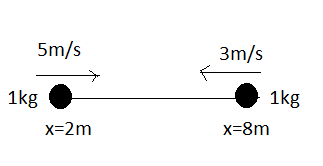Answer
405.3k+ views
Hint: We first find the position of the center of mass of the system using the center of mass formula at time zero. Then we find the velocity of the center of mass. From the velocity of the center of mass, we find the position of the center of mass at a time one second.
Formula used:
Center of mass \[{x_{com}} = \dfrac{{{m_1}{x_1} + {m_2}{x_2}}}{{{m_1} + {m_2}}}\]
Position of particle one and two is represented by \[{x_1},{x_2}\]
Mass of particle one and two is represented by ${m_1},{m_2}$
Center of mass velocity ${V_{com}} = \dfrac{{{m_1}{v_1} + {m_2}{v_2}}}{{{m_1} + {m_2}}}$
Velocity of particle one and two is represented by ${v_1},{v_2}$
Complete step by step answer:
We know the position as well as the mass of the particles from the question.
Mass of particle 1, ${m_1}=1kg$
Mass of particle 2, ${m_2}=1kg$
Position of particle 1, ${x_1}=2m$
Position of particle 2, ${x_2}=8m$
The Center of mass velocity is the ratio of momentum of the particles to the sum of their weight. When the particles move the center of mass also changes along with it. The change in distance of the center of mass with respect to time is the center of mass velocity.
Substituting these values in the center of mass equation we get the position of the center of mass at the time, $t=0$
$ {x_{com}} = \dfrac{{{m_1}{x_1} + {m_2}{x_2}}}{{{m_1} + {m_2}}} $
$ {x_{com}} = \dfrac{{(1 \times 2) + (1 \times 8)}}{{1 + 1}} = 5m $
Velocity of particle 1, ${v_1}=5m/s$ (from left to right)
Velocity of particle 2, ${v_2}=3m/s$ (from right to left)
Substituting these values in center of mass velocity equation
${V_{com}} = \dfrac{{{m_1}{v_1} + {m_2}{v_2}}}{{{m_1} + {m_2}}} = \dfrac{{(1 \times 5) - (1 \times 3)}}{2} = 1m/s$
The velocities are in opposition to each other hence the momentum are subtracted.
From this, we know that for every one second the position of the center of mass changes by $1m$.
The position of the center of mass at the time, $t=1sec$ is $5+1=6m$
Hence the center of mass after one second is at $6m$.
Note:
if we were asked to find the position of the center of mass after two seconds, then we simply multiply the center of mass velocity with 2 and then add it with the initial position of the center of mass. The velocity of the center of mass tells us that in one second the position changes by the specified distance so in two seconds the double the distance is changed.
Formula used:
Center of mass \[{x_{com}} = \dfrac{{{m_1}{x_1} + {m_2}{x_2}}}{{{m_1} + {m_2}}}\]
Position of particle one and two is represented by \[{x_1},{x_2}\]
Mass of particle one and two is represented by ${m_1},{m_2}$
Center of mass velocity ${V_{com}} = \dfrac{{{m_1}{v_1} + {m_2}{v_2}}}{{{m_1} + {m_2}}}$
Velocity of particle one and two is represented by ${v_1},{v_2}$
Complete step by step answer:
We know the position as well as the mass of the particles from the question.
Mass of particle 1, ${m_1}=1kg$
Mass of particle 2, ${m_2}=1kg$
Position of particle 1, ${x_1}=2m$
Position of particle 2, ${x_2}=8m$
The Center of mass velocity is the ratio of momentum of the particles to the sum of their weight. When the particles move the center of mass also changes along with it. The change in distance of the center of mass with respect to time is the center of mass velocity.
Substituting these values in the center of mass equation we get the position of the center of mass at the time, $t=0$
$ {x_{com}} = \dfrac{{{m_1}{x_1} + {m_2}{x_2}}}{{{m_1} + {m_2}}} $
$ {x_{com}} = \dfrac{{(1 \times 2) + (1 \times 8)}}{{1 + 1}} = 5m $
Velocity of particle 1, ${v_1}=5m/s$ (from left to right)
Velocity of particle 2, ${v_2}=3m/s$ (from right to left)
Substituting these values in center of mass velocity equation
${V_{com}} = \dfrac{{{m_1}{v_1} + {m_2}{v_2}}}{{{m_1} + {m_2}}} = \dfrac{{(1 \times 5) - (1 \times 3)}}{2} = 1m/s$
The velocities are in opposition to each other hence the momentum are subtracted.
From this, we know that for every one second the position of the center of mass changes by $1m$.
The position of the center of mass at the time, $t=1sec$ is $5+1=6m$
Hence the center of mass after one second is at $6m$.
Note:
if we were asked to find the position of the center of mass after two seconds, then we simply multiply the center of mass velocity with 2 and then add it with the initial position of the center of mass. The velocity of the center of mass tells us that in one second the position changes by the specified distance so in two seconds the double the distance is changed.
Recently Updated Pages
How many sigma and pi bonds are present in HCequiv class 11 chemistry CBSE

Why Are Noble Gases NonReactive class 11 chemistry CBSE

Let X and Y be the sets of all positive divisors of class 11 maths CBSE

Let x and y be 2 real numbers which satisfy the equations class 11 maths CBSE

Let x 4log 2sqrt 9k 1 + 7 and y dfrac132log 2sqrt5 class 11 maths CBSE

Let x22ax+b20 and x22bx+a20 be two equations Then the class 11 maths CBSE

Trending doubts
Fill the blanks with the suitable prepositions 1 The class 9 english CBSE

At which age domestication of animals started A Neolithic class 11 social science CBSE

Which are the Top 10 Largest Countries of the World?

Give 10 examples for herbs , shrubs , climbers , creepers

Difference between Prokaryotic cell and Eukaryotic class 11 biology CBSE

Difference Between Plant Cell and Animal Cell

Write a letter to the principal requesting him to grant class 10 english CBSE

Change the following sentences into negative and interrogative class 10 english CBSE

Fill in the blanks A 1 lakh ten thousand B 1 million class 9 maths CBSE




